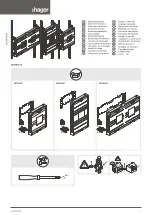
TROUBLESHOOTING
If symptoms of poor performance develop, the fol-
lowing chart can be used as a guide to correct the
problem.
When diagnosing faults in operation of the Post
Puller, always check that the hydraulic power
source is supplying the correct hydraulic fl ow and
pressure to the post puller as listed in the table.
Use a fl owmeter known to be accurate. Check
the fl ow with the hydraulic oil temperature at least
80
°
F/27
°
C.
10
Post Puller does not run.
Power unit not functioning.
Check power unit for proper fl ow and
pressure (3-9 gpm/11-34 lpm, 2000
psi/140
bar).
Coupler or hoses blocked.
Remove restriction.
Mechanical failure of lift cylinder
Disassemble post puller and inspect
assembly.
for damaged parts.
Post Puller does not pull.
Power unit not functioning.
Check power unit for proper pressure
effectively.
(2000 psi/140 bar).
Couplers or hoses blocked.
Remove restriction.
Post Puller operates slow.
Low gpm supply from power unit
Check power source for proper fl ow
(3-9 gpm/11-34 lpm).
Couplers or hoses blocked.
Remove restriction.
Relief valve set too low.
Adjust relief valve to 2100-2250 psi
/145-155
bar.
Post Puller gets hot.
Hot fl uid going through tool.
Check power unit. Make sure the fl ow
rate is not too high causing part of the
fl uid to go through the relief valve.
Provide cooler to maintain proper
fl uid temperature (140
°
F/60
°
C max).
Check relief valve setting.
Eliminate
fl ow control devices.
PROBLEM POSSIBLE
CAUSE
SOLUTION


































